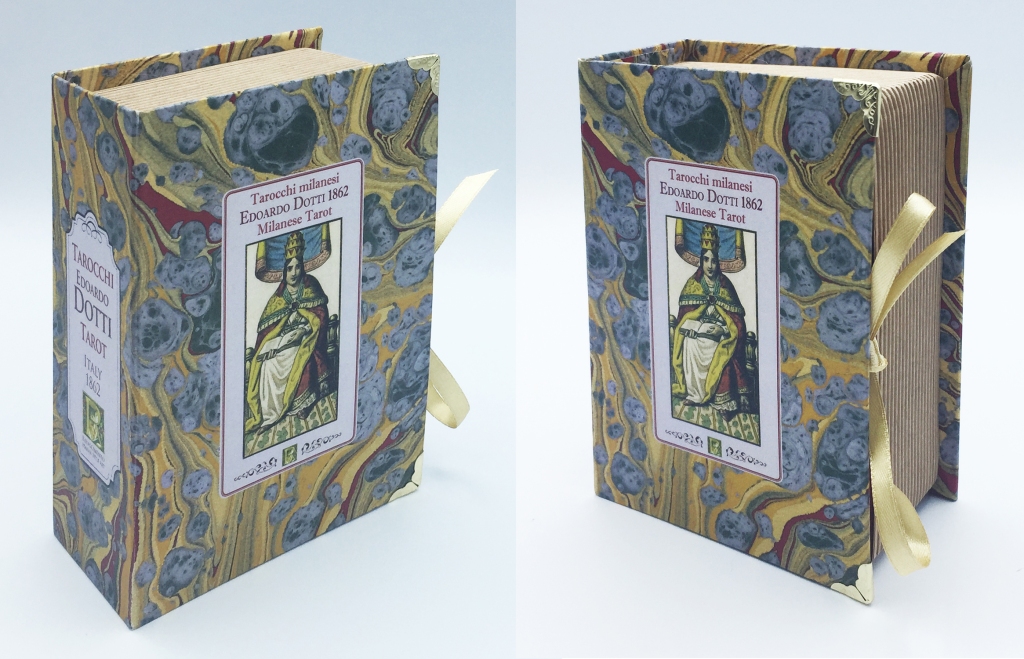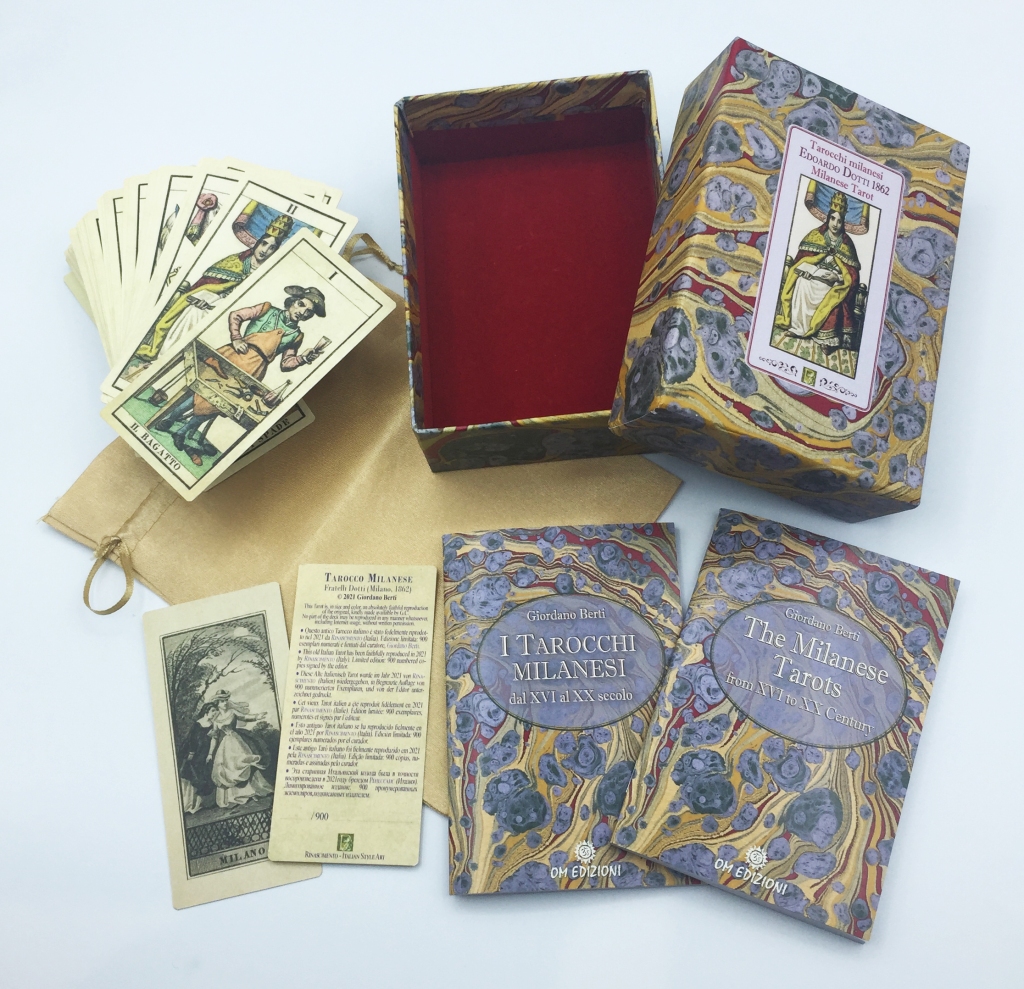Edoardo Dotti’s Milanese Tarot is one of the jewels of European Tarot production in the 19th century.
Rinascimento Italian Style Art has reprinted the Edoardo Dotti’s Tarot in a LIMITED EDITION of 900 numbered copies, absolutely identical to the original deck produced around 1862.

BUY NOW ON ETSY THE DELUXE VERSION
OR
BUY NOW ON ETSY THE ECONOMIC VERSION
CONTENT
Looking at the 78 cards of Edoardo Dotti’s Tarot, the extraordinary resemblance to the splendid deck engraved by Carlo Dellarocca and printed in Milan around 1835 by Ferdinando Gumppenberg, a manufacturer originally from Munich, immediately emerges.
That deck, later renamed “Soprafino”, was the remake of another Milanese deck printed between 1790 and 1810 by Gentilini and Zoya. But the quality of Dellarocca’s figures is infinitely greater than Gentilini-Zoya.

Around 1847, Gumppenberg, now elderly, sold the business to his son-in-law, Lattanzio Lamperti, who dedicated himself to the production of popular decks, both Tarot and common playing cards with Italian or French suits.
Another Milanese manufacturer, Teodoro Dotti, who had been a partner of Gumppenberg from 1838 to 1842, continued on the path taken by the German master and, not having available the copper plates used to print the “Soprafino” Tarot, commissioned an engraver to prepare new plates. Hence the peculiarity of Dotti’s Tarot.
On the death of Teodoro Dotti, which occurred around 1860, his sons were nominally succeeded, but in reality the company was owned by Edoardo, active until 1882.
Edoardo Dotti removed the imperial eagle from the Empress’s shield, symbol of the Austro-Hungarian dominion over Milan until the unification of Italy, which took place in 1861.

A year later, Edoardo Dotti removed from the Ace of Coins the portrait of an unknown person (perhaps his father Theodore) to insert the tax stamp imposed by the administration of the Kingdom of Italy.
Thanks to a collector who owns the first version of Edoardo Dotti’s Tarot (actually signed “Fratelli Dotti”), it was possible to make this reprint, absolutely faithful to the original.

A PRECIOUS BOOKLET
Rinascimento wanted to attach to Edoardo Dotti’s Tarot a historical booklet written by Giordano Berti in which the history of the Milanese Tarot is narrated from its origins, the first decades of the fifteenth century, to the mid-twentieth century, obviously including the particular story that led to the birth of the Edoardo Dotti Tarot.
It is a story that deserves to be known by lovers of Tarot and playing cards all over the world, also for the literary and political aspects that are intertwined with the game of Tarot in Milan.

In fact, the production of Tarots in Milan dates back to the early decades of the fiveteenth century and is testified by the Tarot of Filippo Maria Visconti, now in the Beinecke Library of the Yale University; it is the oldest known Tarot deck known today. For this and other reasons, the most accredited historians believe that Milan is the place where the Tarot was invented.
It is absolutely certain that from Milan, at the beginning of the sixteenth century, a popular version of the Milanese Tarots migrated to France: first to Avignon, then to Paris.
At the end of the seventeenth century this game spread east of Paris, towards the border with Germany and Switzerland, where was developed a model that 230 years later was defined as the “Tarot de Marseille”.
Starting in 1781, that model attracted the attention of esotericists, inspiring an infinity of legends.
In this way the circle is closed: from Paris, Strasbourg, Dijon, Lyon and Marseille, the Tarot retain the traces of the ancient popular Milanese Tarots, as documented in this precious, full-color and richly illustrated booklet.
Another interesting content of this study is related to the tax stamps that allow us to date with extreme accuracy the Tarots printed in Milan from the end of the eighteenth century to 1945.
THIS REPRINT
This very first version of Edoardo Dotti’s Tarot, kindly lent by a collector friend, has been reproduced in an absolutely faithful way to the original in all details: colors, dimensions and back of the cards.
The deck has been printed on special paper in a limited edition of 900 copies.
Each copy is numbered and signed by Giordano Berti on a guarantee card.
The same deck is available both in the Deluxe and in Economic box.
DELUXE BOX
The cards are inserted in an elegant golden bag and, together with the booklet and the leaflet, are inside a refined book-shaped box, created by the art designer Letizia Rivetti and produced by expert Italian artisans on behalf of Rinascimento Italian Style. Art.

BUY NOW ON ETSY THE DELUXE VERSION
ECONOMIC BOX
One can have the same deck, together with the booklet and the leaflet with the divination instructions, in a simpler 2-parts box,.

BUY NOW ON ETSY THE ECONOMIC VERSION
TECHNICAL NOTES
Publisher: OM Edizioni and Rinascimento Italian Style Art, Italy, 2021.
Curator: Giordano Berti
Limited edition: 900 numbered and signed copies.
Deck: 78 cards + 1 guarantee with number and signature of the editor
Card format: 105 × 52 mm
Deluxe box: designed by art designer Letizia Rivetti.
Packaging: “Rinascimento – Italian Style Art”. Craft production. Book-shaped. Velvet interior.
Booklet: by Giordano Berti. 60 full color pages; semi-rigid cover; size 85 × 125 mm. Available in English.
Leaflet: by Giulia Orsini. 8 pages with traditional divinatory meanings of the 78 cards and methods of reading; size 80 × 125 mm. English translation by Adam West-Watson.
